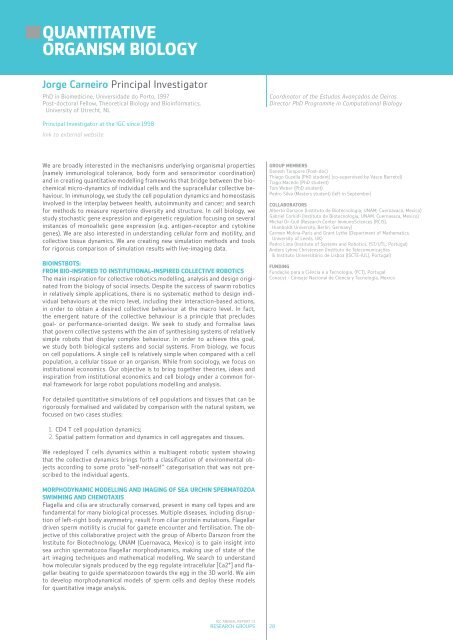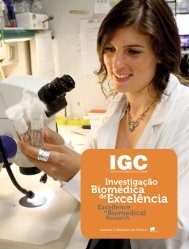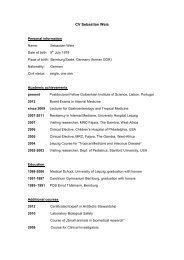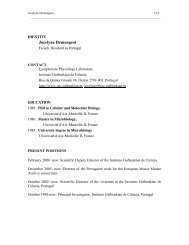organisation - the Instituto Gulbenkian de Ciência
organisation - the Instituto Gulbenkian de Ciência
organisation - the Instituto Gulbenkian de Ciência
- No tags were found...
You also want an ePaper? Increase the reach of your titles
YUMPU automatically turns print PDFs into web optimized ePapers that Google loves.
QUANTITATIVE<br />
ORGANISM BIOLOGY<br />
Jorge Carneiro Principal Investigator<br />
PhD in Biomedicine, Universida<strong>de</strong> do Porto, 1997<br />
Post-doctoral Fellow, Theoretical Biology and Bioinformatics,<br />
University of Utrecht, NL<br />
Coordinator of <strong>the</strong> Estudos Avançados <strong>de</strong> Oeiras<br />
Director PhD Programme in Computational Biology<br />
Principal Investigator at <strong>the</strong> IGC since 1998<br />
link to external website<br />
We are broadly interested in <strong>the</strong> mechanisms un<strong>de</strong>rlying organismal properties<br />
(namely immunological tolerance, body form and sensorimotor coordination)<br />
and in creating quantitative mo<strong>de</strong>lling frameworks that bridge between <strong>the</strong> biochemical<br />
micro-dynamics of individual cells and <strong>the</strong> supracellular collective behaviour.<br />
In immunology, we study <strong>the</strong> cell population dynamics and homeostasis<br />
involved in <strong>the</strong> interplay between health, autoimmunity and cancer; and search<br />
for methods to measure repertoire diversity and structure. In cell biology, we<br />
study stochastic gene expression and epigenetic regulation focusing on several<br />
instances of monoallelic gene expression (e.g. antigen-receptor and cytokine<br />
genes). We are also interested in un<strong>de</strong>rstanding cellular form and motility, and<br />
collective tissue dynamics. We are creating new simulation methods and tools<br />
for rigorous comparison of simulation results with live-imaging data.<br />
BIOINSTBOTS:<br />
FROM BIO-INSPIRED TO INSTITUTIONAL-INSPIRED COLLECTIVE ROBOTICS<br />
The main inspiration for collective robotics mo<strong>de</strong>lling, analysis and <strong>de</strong>sign originated<br />
from <strong>the</strong> biology of social insects. Despite <strong>the</strong> success of swarm robotics<br />
in relatively simple applications, <strong>the</strong>re is no systematic method to <strong>de</strong>sign individual<br />
behaviours at <strong>the</strong> micro level, including <strong>the</strong>ir interaction-based actions,<br />
in or<strong>de</strong>r to obtain a <strong>de</strong>sired collective behaviour at <strong>the</strong> macro level. In fact,<br />
<strong>the</strong> emergent nature of <strong>the</strong> collective behaviour is a principle that preclu<strong>de</strong>s<br />
goal- or performance-oriented <strong>de</strong>sign. We seek to study and formalise laws<br />
that govern collective systems with <strong>the</strong> aim of syn<strong>the</strong>sising systems of relatively<br />
simple robots that display complex behaviour. In or<strong>de</strong>r to achieve this goal,<br />
we study both biological systems and social systems. From biology, we focus<br />
on cell populations. A single cell is relatively simple when compared with a cell<br />
population, a cellular tissue or an organism. While from sociology, we focus on<br />
institutional economics. Our objective is to bring toge<strong>the</strong>r <strong>the</strong>ories, i<strong>de</strong>as and<br />
inspiration from institutional economics and cell biology un<strong>de</strong>r a common formal<br />
framework for large robot populations mo<strong>de</strong>lling and analysis.<br />
GROUP MEMBERS<br />
Danesh Tarapore (Post-doc)<br />
Thiago Guzella (PhD stu<strong>de</strong>nt) (co-supervised by Vasco Barreto))<br />
Tiago Macedo (PhD stu<strong>de</strong>nt)<br />
Tom Weber (PhD stu<strong>de</strong>nt)<br />
Pedro Silva (Masters stu<strong>de</strong>nt) (left in September)<br />
COLLABORATORS<br />
Alberto Darszon (<strong>Instituto</strong> <strong>de</strong> Biotecnologia, UNAM, Cuernavaca, Mexico)<br />
Gabriel Corkidi (<strong>Instituto</strong> <strong>de</strong> Biotecnologia, UNAM, Cuernavaca, Mexico)<br />
Michal Or-Guil (Research Center ImmunoSciences (RCIS),<br />
Humboldt University, Berlin, Germany)<br />
Carmen Molina-Paris and Grant Ly<strong>the</strong> (Department of Ma<strong>the</strong>matics.<br />
University of Leeds, UK)<br />
Pedro Lima (Institute of Systems and Robotics. IST/UTL, Portugal)<br />
An<strong>de</strong>rs Lyhne Christensen (<strong>Instituto</strong> <strong>de</strong> Telecomunicações<br />
& <strong>Instituto</strong> Universitário <strong>de</strong> Lisboa (ISCTE-IUL), Portugal)<br />
FUNDING<br />
Fundação para a Ciência e a Tecnologia, (FCT), Portugal<br />
Conacyt - Consejo Nacional <strong>de</strong> Ciencia y Tecnología, Mexico<br />
For <strong>de</strong>tailed quantitative simulations of cell populations and tissues that can be<br />
rigorously formalised and validated by comparison with <strong>the</strong> natural system, we<br />
focused on two cases studies:<br />
1. CD4 T cell population dynamics;<br />
2. Spatial pattern formation and dynamics in cell aggregates and tissues.<br />
We re<strong>de</strong>ployed T cells dynamics within a multiagent robotic system showing<br />
that <strong>the</strong> collective dynamics brings forth a classification of environmental objects<br />
according to some proto “self-nonself” categorisation that was not prescribed<br />
to <strong>the</strong> individual agents.<br />
MORPHODYNAMIC MODELLING AND IMAGING OF SEA URCHIN SPERMATOZOA<br />
SWIMMING AND CHEMOTAXIS<br />
Flagella and cilia are structurally conserved, present in many cell types and are<br />
fundamental for many biological processes. Multiple diseases, including disruption<br />
of left-right body asymmetry, result from ciliar protein mutations. Flagellar<br />
driven sperm motility is crucial for gamete encounter and fertilisation. The objective<br />
of this collaborative project with <strong>the</strong> group of Alberto Darszon from <strong>the</strong><br />
Institute for Biotechnology, UNAM (Cuernavaca, Mexico) is to gain insight into<br />
sea urchin spermatozoa flagellar morphodynamics, making use of state of <strong>the</strong><br />
art imaging techniques and ma<strong>the</strong>matical mo<strong>de</strong>lling. We search to un<strong>de</strong>rstand<br />
how molecular signals produced by <strong>the</strong> egg regulate intracellular [Ca2+] and flagellar<br />
beating to gui<strong>de</strong> spermatozoon towards <strong>the</strong> egg in <strong>the</strong> 3D world. We aim<br />
to <strong>de</strong>velop morphodynamical mo<strong>de</strong>ls of sperm cells and <strong>de</strong>ploy <strong>the</strong>se mo<strong>de</strong>ls<br />
for quantitative image analysis.<br />
IGC ANNUAL REPORT ‘11<br />
RESEARCH GROUPS<br />
28






